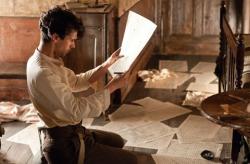What Would the Cloud Atlas Sextet Really Sound Like?

Reiner Bajo / Warner Brothers
In what may be the best of Cloud Atlas's trans-historical sextet of tales, a young composer, Robert Frobisher, struggles to complete his masterpiece. In the novel upon which the film is based, David Mitchell spends a fair number of words describing Frobisher’s music, so the team tasked with creating a version of it for the movie—Tom Tykwer (who directed the film along with the Wachowski siblings), Johnny Klimek, and Reinhold Heil—faced an unusual challenge: Would they try to turn those words into music, or create a new sound of their own?
According to Grantland, the composers found that hewing too closely to Mitchell’s rather avant-garde descriptions in crafting their score produced results that weren’t “very satisfying for the film.” Though the team did attempt to make Frobisher’s piece, called the Cloud Atlas Sextet, sound “Debussy-ish”—following Mitchell’s mention of the late-Romantic composer—they wisely made music that could provide connective tissue for a disjointed movie that badly needed it.
But that doesn’t mean that Frobisher’s piece would be impossible to create in real life. What would the Cloud Atlas Sextet described in the novel actually sound like?
Structurally, we know that Frobisher wrote a sextet—a piece for six instrumental voices—with “overlapping soloists” in which “each solo is interrupted by its successor” in a first section, while “in the second, each interruption is recontinued, in order.” (This arrangement mirrors the presentation of the six storylines in the book). Frobisher also mentions the instrumentation: piano, clarinet, cello, flute, oboe, and violin.
Frobisher reveals that his sextet is constructed from a year’s worth of “fragments,” and so by looking earlier in his letters to his lover Sixsmith, we can glean more information. One such fragment is described as a “cello allegro lit by explosive triplets,” or, in plain language, a lively passage for cello featuring a lilting rhythmic pattern grouped in threes. We can even make an educated guess as to the key. Frobisher writes of a dream in which shattering china in a shop produces music instead of crashes: “an august chord rang out, half-cello, half-celeste, D major (?), held for four beats.” Most classical music begins on the chord that defines the piece’s overall key (known as the tonic). This opening D major chord is followed by “E-flat, whole string section, glorious, transcendent, angels wept.” Frobisher later tries to write this dreamy music down, so we can assume this is one of the fragments he incorporates into the Sextet.
Frobisher shows a friend the piece’s “clarinet cadenza,” a virtuosic and sometimes improvisatory passage for a soloist that usually comes toward the end of composition. The friend is “unnerved at first by its spectral and structural peculiarities,” but “spends a further hour asking perceptive questions about my semi-invented notation and the singular harmonics of the piece.” Frobisher also observes that the “boundaries between noise and sound are conventions,” foreshadowing the thinking of composers like John Cage, and says that there is an “island” his music inhabits “midstream between timbre and rhythm, not down in any book of theory.” How these tantalizing nuggets would manifest in actual music isn’t entirely clear, but they tell us for certain that Frobisher was sensitive to the radical shifts in harmony, structure, and even notation that were swirling in the 1930s.
In perhaps the most revealing passage, Frobisher names direct influences on his composition: “Echoes of Scriabin’s White Mass, Stravinsky’s lost footprints, chromatics of the more lunar Debussy, but truth is I don’t know where it came from.”
Scriabin’s “White Mass,” properly known as the Piano Sonata No. 7, Op. 64, was composed in 1911 and is characterized by striking flirtations with atonality and florid, roiling, impressionistic textures. The piece’s single movement dives and crashes through various moods, though mystical ecstasy is the primary one. Given Frobisher’s own interest in mystical ideas, his attraction to this transcendent music is unsurprising.
The Stravinsky nod is vaguer, but Frobisher’s fictional biography provides a plausible explanation. In December 1930, about six months before Frobisher’s first letter to Sixsmith, Igor Stravinsky premiered his neoclassical work Symphony of Psalms in Brussels, Belgium, the country to which Frobisher would soon move. The three-movement choral symphony takes as its text Psalms 38, 40, and 150, the first two of which deal with the psalmist’s being a “sojourner” and the Lord having “set [his] feet upon the rock, and ordered [his] goings.” Could this wandering music be Stravinsky’s “lost footprints?” Perhaps.
Finally, the Debussy “lunar” reference—from which Tywker and his co-composers apparently took the most inspiration—could very well refer to the French impressionist master’s fascination with la lune. Most famous, of course, is the “classical favorite” Clair de Lune, but given Frobisher’s mention of “chromatics” (roughly speaking, the introduction of notes external to and often dissonant with the primary key/scale of the music), we should look beyond such relatively tame stuff. More likely, Frobisher is referring to the movement from Debussy’s second series of Images titled Et la lune descend sur le temple qui fut or the prelude called La terrasse des audiences du clair de lune, both of which were composed in the first decade or so of the 20th century. Debussy’s haunting, majestic nocturnal reveries perfectly jibe with Frobisher’s description of his Sextet as a “waking dream.”

